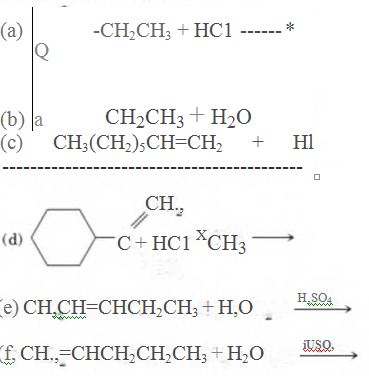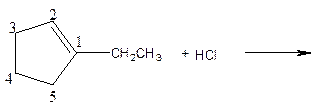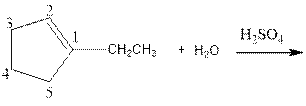
Concept explainers
12-42 Complete these equations.

(a)
Interpretation:
Complete the below equation:

Concept introduction:
During the hydration of alkene the unsaturated alkene converted into saturated alkane with the addition of H+ and Cl- ions. This reaction is carried out in the presence of acid therefore it is called acid catalyzed hydration of alkene.
Answer to Problem 32P

Explanation of Solution
As per the given equation, the reactant is a cyclic alkene to which HCl is added. And the characteristics reactions given by the alkenes are addition reactions in which the addition takes place at the double bond. The addition follows the Markovnikov’s rule.
As per the Markovnikov’s rule, the hydrogen acid is added to the carbon of a double bond containing higher number of hydrogens in it. The halogen part is added to the carbon in the double bond containing fewer number of hydrogens in it. Here, the positive part is H+ and the halogen part is Cl-. On numbering the carbon atoms, the structure is.

Now as per the rule, the hydrogen in the above equation attaches to carbon 2 as carbon 2 of the double bond has one hydrogen attached to it. The Cl- will attached to carbon 1 as it has no carbon attached to it. Thus, the complete reaction is:

(b)
Interpretation:
Complete the below equation:

Concept introduction:
During the hydration of alkene the unsaturated alkene converted into saturated alkane with the addition of H+ and OH- ions in the presence of H2 SO4. This reaction is carried out in the presence of acid therefore it is called acid catalyzed hydration of alkene.
Answer to Problem 32P

Explanation of Solution
As per the given equation, the reactant is a cyclic alkene to which H2 O is added. And the characteristics reactions given by the alkenes are addition reactions in which the addition takes place at the double bond. The addition follows the Markovnikov’s rule.
As per the Markovnikov’s rule, the hydrogen acid is added to the carbon of a double bond containing higher number of hydrogens in it. The halogen part is added to the carbon in the double bond containing fewer number of hydrogens in it. Here, the positive part is H+ and the halogen part is OH-. On numbering the carbon atoms, the structure is.

Now as per the rule, the hydrogen in the above equation attaches to carbon 2 as carbon 2 of the double bond has one hydrogen attached to it. The OH- will attached to carbon 1 as it has no carbon attached to it. Thus, the complete reaction is:

(c)
Interpretation:
Complete the below equation:

Concept introduction:
During the hydration of alkene the unsaturated alkene converted into saturated alkane with the addition of H+ and I- ions.
Answer to Problem 32P

Explanation of Solution
As per the above equation, the reactant is an alkene to which HI is added. We also know that the characteristics reactions given by alkenes are addition reactions in which the addition takes place at the double bond. This addition follows the Markovnikov’s rule.
As per the Markovnikov’s rule, the hydrogen acid is added to the carbon of a double bond containing higher number of hydrogens in it. The halogen part is added to the carbon in the double bond containing fewer number of hydrogens in it. Here, the positive part is H+ and the halogen part is I-. On numbering the double bonded carbons of the alkene, the structure is.

Now as per the rule, the hydrogen in the above equation attaches to carbon 1 as carbon 1 of the double bond has two hydrogen attached to it. The I- will attached to carbon 2 as it has only one carbon attached to it. Thus, the complete reaction is:

(d)
Interpretation:
Complete the below equation:

Concept introduction:
As per the Markovnikov’s rule, the hydrogen acid is added to the carbon of a double bond containing higher number of hydrogens in it. The halogen part is added to the carbon in the double bond containing fewer number of hydrogens in it.
Answer to Problem 32P

Explanation of Solution
As per the above equation, the reactant is an alkene to which HCl is added. We also know that the characteristics reactions given by alkenes are addition reactions in which the addition takes place at the double bond. This addition follows the Markovnikov’s rule.
As per the Markovnikov’s rule, the hydrogen acid is added to the carbon of a double bond containing higher number of hydrogens in it. The halogen part is added to the carbon in the double bond containing fewer number of hydrogens in it. Here, the positive part is H+ and the halogen part is Cl-. On numbering the double bonded carbons of the alkene, the structure is.

Now as per the rule, the hydrogen in the above equation attaches to carbon 1 as carbon 1 of the double bond has two hydrogen attached to it. The Cl- will attached to carbon 2 as it has only no carbon attached to it. Thus, the complete reaction is:

(e)
Interpretation:
Complete the below equation:

Concept introduction:
During the hydration of alkene the unsaturated alkene converted into saturated alkane with the addition of H+ and OH- ions in the presence of H2 SO4. This reaction is carried out in the presence of acid therefore it is called acid catalyzed hydration of alkene.
Answer to Problem 32P

Explanation of Solution
As per the above equation, the reactant is an alkene to which H2 O is added. We also know that the characteristics reactions given by alkenes are addition reactions in which the addition takes place at the double bond. This addition follows the Markovnikov’s rule.
As per the Markovnikov’s rule, the hydrogen acid is added to the carbon of a double bond containing higher number of hydrogens in it. The halogen part is added to the carbon in the double bond containing fewer number of hydrogens in it. Here, the positive part is H+ and the halogen part is OH-. On numbering the alkene, the structure is.

Now the below product will form where hydrogen will attach to the 2nd carbon to form more suitable product:

(f)
Interpretation:
Complete the below equation:

Concept introduction:
During the hydration of alkene the unsaturated alkene converted into saturated alkane with the addition of H+ and OH- ions in the presence of H2 SO4. This reaction is carried out in the presence of acid therefore it is called acid catalyzed hydration of alkene.
Answer to Problem 32P

Explanation of Solution
As per the above equation, the reactant is an alkene to which H2 O is added. We also know that the characteristics reactions given by alkenes are addition reactions in which the addition takes place at the double bond. This addition follows the Markovnikov’s rule.
As per the Markovnikov’s rule, the hydrogen acid is added to the carbon of a double bond containing higher number of hydrogens in it. The halogen part is added to the carbon in the double bond containing fewer number of hydrogens in it. Here, the positive part is H+ and the halogen part is OH-. On numbering the alkene, the structure is.

Now as per the rule, the hydrogen in the above equation attaches to carbon 1 as carbon 1 of the double bond has two hydrogen attached to it. The OH- will attached to carbon 2 as it has only one carbon attached to it. Thus, the complete reaction is:

Want to see more full solutions like this?
Chapter 12 Solutions
Introduction to General, Organic and Biochemistry
- Please analze my gel electrophoresis column of the VRK1 kinase (MW: 39.71 kDa). Attached is the following image for the order of column wells and my gel.arrow_forward2.0arrow_forwardWrite the electron configuration of an atom of the element highlighted in this outline of the Periodic Table: 1 23 4 5 6 7 He Ne Ar Kr Xe Rn Hint: you do not need to know the name or symbol of the highlighted element! ☐arrow_forward
- Compare these chromatograms of three anti-psychotic drugs done by HPLC and SFC. Why is there the difference in separation time for SFC versus HPLC? Hint, use the Van Deemter plot as a guide in answering this question. Why, fundamentally, would you expect a faster separation for SFC than HPLC, in general?arrow_forwardA certain inorganic cation has an electrophoretic mobility of 5.27 x 10-4 cm2s-1V-1. The same ion has a diffusion coefficient of 9.5 x 10-6cm2s-1. If this ion is separated from cations by CZE with a 75cm capillary, what is the expected plate count, N, at an applied voltage of 15.0kV? Under these separation conditions, the electroosmotic flow rate was 0.85mm s-1 toward the cathode. If the detector was 50.0cm from the injection end of the capillary, how long would it take in minutes for the analyte cation to reach the detector after the field was applied?arrow_forward2.arrow_forward
- Please solve for the following Electrochemistry that occursarrow_forwardCommercial bleach contains either chlorine or oxygen as an active ingredient. A commercial oxygenated bleach is much safer to handle and less likely to ruin your clothes. It is possible to determine the amount of active ingredient in an oxygenated bleach product by performing a redox titration. The balance reaction for such a titration is: 6H+ +5H2O2 +2MnO4- à 5O2 + 2Mn2+ + 8H2O If you performed the following procedure: “First, dilute the Seventh Generation Non-Chlorine Bleach by pipetting 10 mL of bleach in a 100 mL volumetric flask and filling the flask to the mark with distilled water. Next, pipet 10 mL of the diluted bleach solution into a 250 mL Erlenmeyer flask and add 20 mL of 1.0 M H2SO4 to the flask. This solution should be titrated with 0.0100 M KMnO4 solution.” It took 18.47mL of the KMnO4 to reach the endpoint on average. What was the concentration of H2O2 in the original bleach solution in weight % assuming the density of bleach is 1g/mL?arrow_forward10.arrow_forward
- Proper care of pH electrodes: Why can you not store a pH electrode in distilled water? What must you instead store it in? Why?arrow_forwardWrite the electron configuration of an atom of the element highlighted in this outline of the Periodic Table: 1 23 4 569 7 He Ne Ar Kr Xe Rn Hint: you do not need to know the name or symbol of the highlighted element! §arrow_forwardIdentify the amino acids by name. Illustrate a titration curve for this tetrapeptide indicating the pKa's for each ionizable groups and identify the pI for this tetrapeptide. please helparrow_forward
 Introduction to General, Organic and BiochemistryChemistryISBN:9781285869759Author:Frederick A. Bettelheim, William H. Brown, Mary K. Campbell, Shawn O. Farrell, Omar TorresPublisher:Cengage Learning
Introduction to General, Organic and BiochemistryChemistryISBN:9781285869759Author:Frederick A. Bettelheim, William H. Brown, Mary K. Campbell, Shawn O. Farrell, Omar TorresPublisher:Cengage Learning General, Organic, and Biological ChemistryChemistryISBN:9781285853918Author:H. Stephen StokerPublisher:Cengage Learning
General, Organic, and Biological ChemistryChemistryISBN:9781285853918Author:H. Stephen StokerPublisher:Cengage Learning Organic And Biological ChemistryChemistryISBN:9781305081079Author:STOKER, H. Stephen (howard Stephen)Publisher:Cengage Learning,
Organic And Biological ChemistryChemistryISBN:9781305081079Author:STOKER, H. Stephen (howard Stephen)Publisher:Cengage Learning,- Chemistry: Matter and ChangeChemistryISBN:9780078746376Author:Dinah Zike, Laurel Dingrando, Nicholas Hainen, Cheryl WistromPublisher:Glencoe/McGraw-Hill School Pub Co



